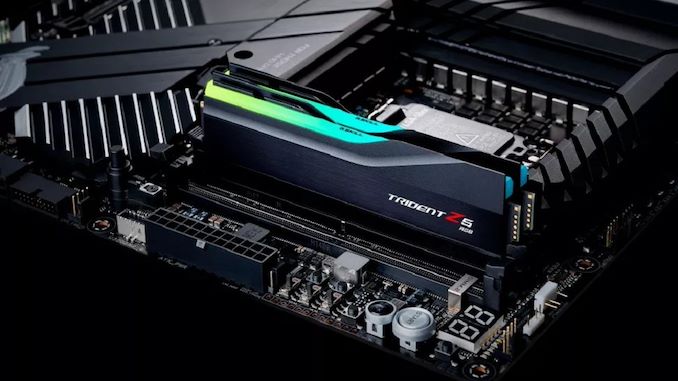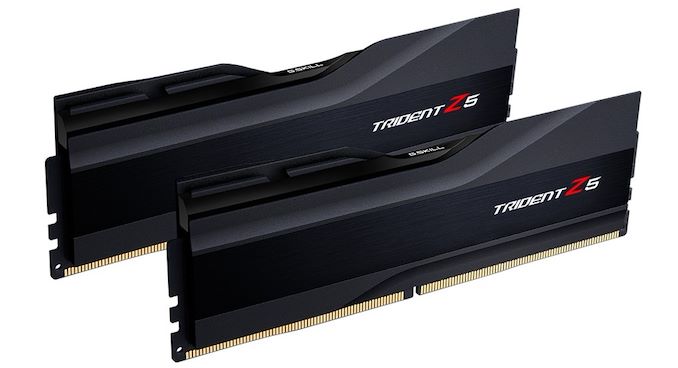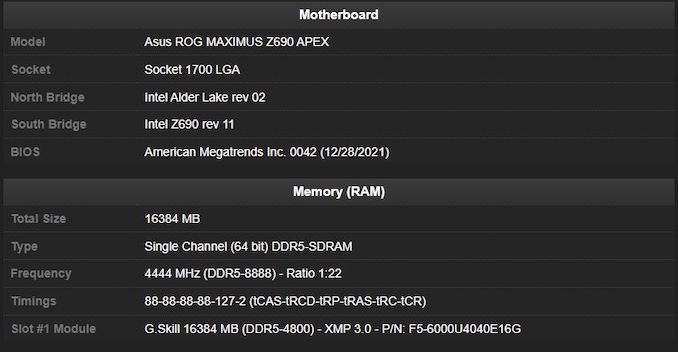G.Skill Blitzes DDR5 World Record With Trident Z5 at DDR5-8888
by Gavin Bonshor on January 25, 2022 12:30 PM EST
For users buying a memory kit of DDR5, if they want to adhere to Intel specifications, will buy a DDR5-4800 kit. Though through XMP, there are other faster kits available - we've even tested G.Skill's DDR5-6000 kit in our memory scaling article. But going above and beyond that, there's overclocking.
Back in November 2021, extreme overclocker 'Hocayu' managed to achieve DDR5-8704 using G.Skill's Trident Z5 DDR5-6000 memory. As always with these records, they are made to be broken, and fellow Hong-Kong native lupin_no_musume has managed to surpass this with an impressive DDR5-8888, also using G.Skill Trident Z5 memory, with an ASUS's ROG Maximus Z690 Apex motherboard, Intel's Core i9-12900K processor, and some liquid nitrogen.
Without trying to sound controversial, indeed, extreme overclocking isn't as popular as it once was. That isn't to say it doesn't have a purpose - using sub-ambient cooling methods such as liquid nitrogen, dry ice, and even liquid helium can boost frequencies on processors and graphics cards well beyond what's achievable with standard cooling. Doing this not only shows the potential of hardware, but it also gives companies 'bragging rights' as being the proud owners of overclocking world records. Car companies boast about the best Nürburgring record for a variety of categories, or tuning their mainstream offerings, in a similar fashion.

G.Skill Trident Z5 DDR5-6000 (2 x 16 GB) memory kit.
This not only pushes the boundaries of what DDR5 memory is capable of, but it's also an impressive feat given DDR5 is relatively nascent. For reference, going from DDR5-6000 to DDR5-8888 represents an overclock of around 48% over the XMP profile and a crazy 85% overclock over the JEDEC specification of DDR5-4800. It should be worth noting that this is an all out data rate record regardless of latency, which in this case was increased to 88 over the standard 40, for stability. Going back to the car analogy, this would be akin to speed records on the drag strip, rather than on the oval.
Screenshot from G.Skill Trident Z5 DDR5-8888 CPU-Z validation (link)
While speeds of DDR5-8888 are not attainable in the form of purchasable memory kits for Alder Lake, G.Skill did unveil a retail kit that tops out at DDR5-7000. We also reported back in November 2021 that S.K. Hynix was planning for DDR5-8400 at 1.1 volts, but that's actually part of the extended JEDEC specifications for when processors get verfied at that speed.
Source: G.Skill











15 Comments
View All Comments
RealBeast - Tuesday, January 25, 2022 - link
"actually part of the entended JEDEC specifications"Perhaps extended?
Oxford Guy - Tuesday, January 25, 2022 - link
The latency certainly will be, to obtain that voltage.linuxgeex - Monday, January 31, 2022 - link
They mean almost the same thing. It means stretched out, like the skin of a drum, which in this case is perhaps even more fitting than extended because it suits the idea of being stretched to its limits lol.thestryker - Tuesday, January 25, 2022 - link
After seeing a video der8auer did regarding DDR5 and heat/heatsinks I'm really curious if memory makers are going to have to take it seriously again. His tested Corsair Dominator actually ran hotter than the basic stick because the heatsink wasn't designed to do much beyond hold the LEDs. As the speeds keep going up it sure seems like proper heatsinks are in order.meacupla - Tuesday, January 25, 2022 - link
I don't think memory rebadgers ever took memory cooling seriously. Even when memory 'heat spreaders' first caught on, they were widely considered to be useless, or even detremental. Memory slots during DDR1/2/3 era were tightly packed, and 'heat spreaders' blocked airflow over RAM. If there were four slots used, the middle two slots were, usually, the first to die.I think DDR5 runs hotter than DDR4, not directly because of the speed, but because the voltage regulator is sitting on the DIMM, rather than the mobo.
thestryker - Tuesday, January 25, 2022 - link
Yeah I remember the original ones with DDR where they were only good if you could separate them. I had some during the DDR2/3 era which were actually decent. I *think* it was OCZ that had one with a heatpipe.Agreed that the PMIC etc being on the sticks is definitely adding to the heat, but the increased speed is certainly adding to it.
whatthe123 - Tuesday, January 25, 2022 - link
they all make things worse by intentionally making bulky covers so they "feel" more premium even though they're useless for heat transfer. a thin piece of copper on each side would be more than enough for the power DDR5 pulls, and probably better for keeping temps down when all slots are loaded.PeachNCream - Friday, January 28, 2022 - link
Its hard to take someone seriously when they publish something under a name like der8auer. Like if this person is going to advocate for something, doing so with a less silly name might help rational people accept the message.Kougar - Wednesday, January 26, 2022 - link
DDR5-8888 CL88 is ouch. That's twice the latency Buildzoid was running a an unreleased kit at, DDR5-6190 CL32ddhelmet - Wednesday, January 26, 2022 - link
What would be the effective latency?